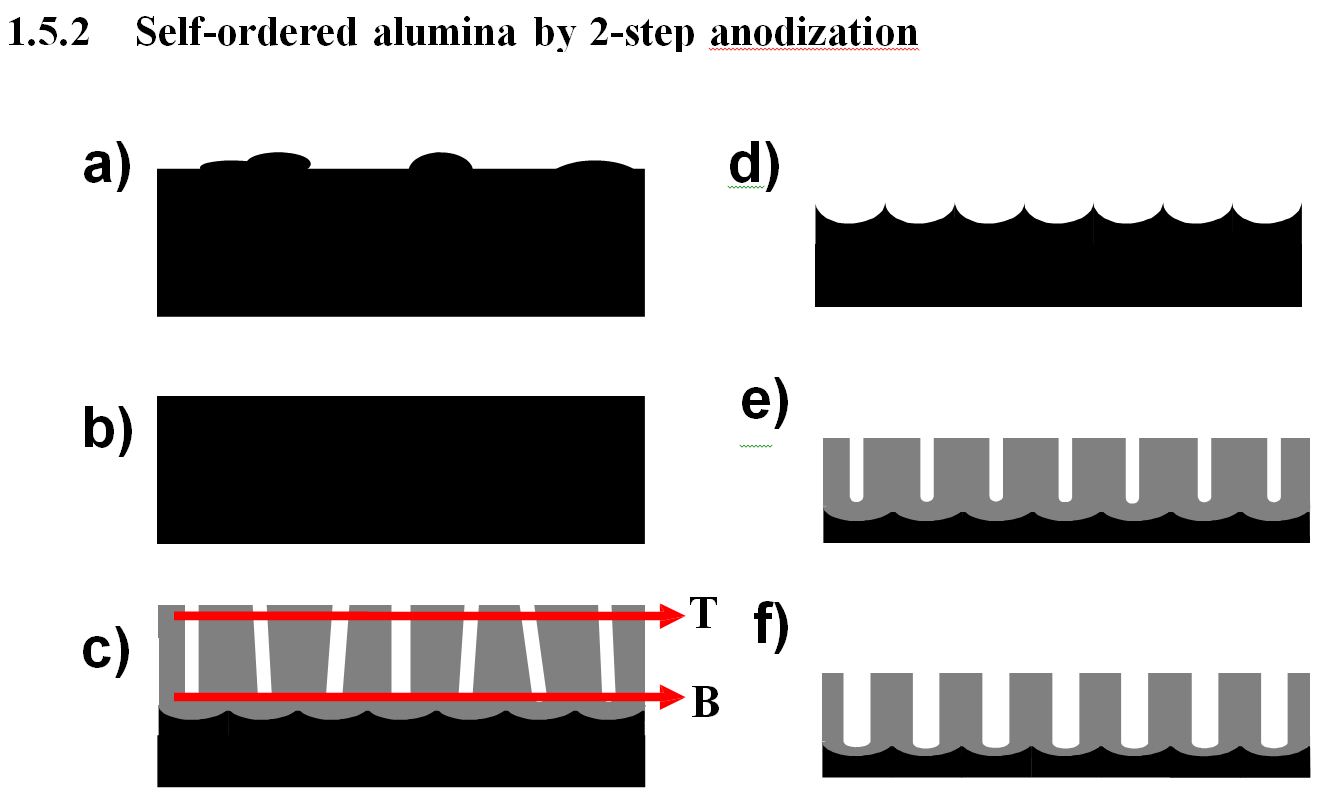Manufacturing in China Blog
Here you can leave comments and start discussions about manufacturing parts of complete products in China.
Anodizing of aluminium
- Hits: 7370
- 0 Comments
- Subscribe to updates
- Bookmark
The history of electrochemical oxidation of aluminium dates back to the beginning of the last century. Anodic treatment of aluminum were intensively investigated to obtain protective and decorative films on its surface [1]. More recently, applications of porous alumina with a huge surface area and a relatively narrow pore size distribution have been exploited [2]. For example, several attempts to fabricate inorganic membranes have been reported [3, 4, 5]. Nowadays, porous alumina is one of the most prominent template materials for synthesis of nanowires or nanotubes with monodisperse controllable diameter and high aspect ratios [6, 7, 8, 9, 10, 11,12, 13, 14]. Moreover, it can be employed as a 2-D photonic crystal.
Numerous patents had been published before the 1950’s, concerning the anodization of alu- minum for coloring [15]. Since the early years, anodic processes at DC or AC current based on either chromic, sulfuric or oxalic acid as electrolytes have been paid attention to [15]. Con- sequently, it was observed that additives such as metal salts like copper, nickel, silver, arsenic, antimony, bismuth, tellurium, selenium or tin lead to a change of the physical and mechani- cal properties as well as of the colors of the oxide. Bengough’s and Stuart’s patent in 1923 is recognized as the first patent for protecting Al and its alloys from corrosion by means of an anodic treatment [16]. In 1936, Caboni invented the famous coloring method consisting of two sequential processes: anodization in sulfuric acid, followed by the application of an alternating current in a metal salt solution [17].
The development of electron microscopy led to a deeper understanding of the porous alumina structures. In 1953, Keller and his coworkers described a porous alumina model as a hexag- onally close-packed duplex structure consisting of porous and barrier layers [18]. Also, they demonstrated the relationship of an applied potential and the geometric features of the hexago- nal porous structures such as the interpore distance. This model was the basis for initial studies that aimed at better a understanding of the physical and chemical properties of porous alumina.
A review paper dealing with anodic oxide films on aluminum was already published in 1968 [19]. Structural features concerning anion incorporation and water content in the oxide and theoretical models of formation mechanisms of both the barrier-type oxide and the porous-type oxide were described in detail in this paper.
Between 1970 and 1990, studies by the Manchester group (led by Thompson and Wood) re- sulted in a deep insight in the growth mechanisms of alumina oxide films. This was possible by the uses of new techniques such as Transmission Electron Microscopy (TEM), marker methods and microtome sectioning. [20, 21, 22, 23]. A corresponding publication by O’Sullivan and Wood is one of the most cited articles on anodization of aluminum to obtain porous alumina structures [24]. Efforts on theoretical modelling of porous oxide growth were carried out by several groups [25, 26, 27, 28, 29, 30, 31, 32, 33]. Fundamentally, an instability mechanism in terms of a field focusing phenomenon was attributed to create pores in the barrier oxide. In these papers, it is claimed that the theoretic modelling of the pore formation mechanism in alumina is analogous to that for other porous materials which can be obtained via an anodic treatment, for example, mciroporous silicon.
Based on a two-step replicating process, a self-ordered porous alumina membrane with 100 nm interpore distance was synthesized by Masuda and Fukuda in 1995 [34]. This discovery was a breakthrough in the preparation of 2D-polydomain porous alumina structures with a very narrow size distribution and extremely high aspect ratios. Two years later, they combined the aluminum anodization method with nanoimprint technologies, which allowed for the first time the preparation of a monodomain porous alumina structure [35]. Numerous other groups, not mentioned here specifically, have also contributed to an improve- ment of porous alumina structures. The purpose of this dissertation is to understand self-assembly of porous alumina under spe- cific conditions (Chapter 1 and Chapter 2). In addition, nanoimprint methods are developed to obtain monodomain porous alumina structures (Chapter 3). These nanoimprint methods are further advanced to fabricate porous alumina arrays with various configurations (Chapter 4). Furthermore, the combination of nanoimprint and anodization will be applied to obtain porous oxides grown on titanium, which is also a valve metal1 (Chapter 5). Finally, in the last two chapters, applications of the alumina templates will be discussed, for example, templates for monodisperse silver nanowires (Chapter 6) and 2D-photonic crystals (Chapter 7).
1.2 Electrochemistry of anodic alumina
1.2.1 Thermodynamics
The spontaneous reaction leading to the formation of aluminum oxide in air can be ascribed to the large negative Gibb’s free energy changes [36].
2Al(s) +2 O2(g) −→ αAl2O3(s) ; ΔG◦ = −1582kJ/mol (1.1)
2Al(s) + 3H2 O(l) −→ αAl2 O3(s) + 3H2(g) ; ΔG◦ = −871kJ/mol (1.2)
If aluminum is electrochemically anodized, an oxide grows at the anode electrode [37],
2Al(s) + 3H2 O(l) = Al2O3 (s) + 6H + + 6e− , (1.3)
and hydrogen evolves at the cathode
6H + + 6e− = 3H2(g). (1.4)
Assuming there are no complex anions, the Nernst equation reads
E = E0 − ( zF )ln( [ox] ) (1.5)
where R is the universal gas constant, T is the absolute temperature in Kelvin, z is the charge number of the electrode reaction, and F is the Faraday constant (96,500 C mol−1). The electrode potential E at the anode can be written as
E = −1.550 − 0.0591pH (1.6)
Table 1.1: Alumina oxide forms [39]
| Name | Crystalline form | Density (g/cm3) / Crystal system | Remark |
| Corundum |
α-Al2O3 |
3.97 / hexagonal |
found in nature |
| Boehmite | α-Al2 O3 ·H2O | 3.44 / ortho-rhombic | |
| Gibbsite | α-Al2O3·(H2O)3 | 2.42 / monoclinic | |
| Diaspore | β-Al2O3·(H2O) | 3.4 / ortho-rhombic | no occurrence in nature |
| Bayerite | β-Al2O3·(H2O)3 | 2.53 / monoclinic | |
| Gamma alumina | γ-Al2O3 |
anhydrous alumina with ill-defined structure |
This explains that the reaction at the anode electrode (Al) thermodynamically depends on the pH value, which is determined by electrolyte and temperature.
1.2.2 Kinetics
The current density passing across the oxide film can be written as [19, 37]
j = ja + jc + je (1.7)
where ja , jc and je are the anion-contributing, cation-contributing and electron-contributing cur- rent density, respectively. Since the electronic conductivity in the aluminum oxide is very low, the ionic current density (ji = ja + jc) is the predominant mode to transport the charges. The relationship between the ionic current, ji , and the electric field, E, can be expressed in terms of the Guntherschultze-Betz equation
ji = j0 exp(βE) (1.8)
where both j0 and β are temperature- and metal-dependent parameters. For the aluminum oxide, the electric field E, j0 and β are in the range of 106 to 107 V/cm, 1 × 10−16 to 3 × 10−2 mA/cm2 and 1 × 10−7 to 5.1 × 10−6 cm/V, respectively [38]. Based on the Guntherschultze- Betz equation, the rate-limiting steps of the film formation are determined by the ionic transport either at the metal/oxide interface, within the bulk oxide or at the oxide/electrolyte interface [19]. Nowadays, it is generally accepted that the oxides simultaneously grow at both interfaces, e.g., at the metal/oxide interface by Al3+ transport and at the oxide/electrolyte interface by oxygen ion transport [21, 24]. For example, the transport number2 of Al3+ anions, tAl3+ , and the cation transport number, tO2− , were reported as 0.45 and 0.55, respectively, for 5mA/cm2 [22].
1.3 Composition of the oxide
Due to a number of polymorphs, hydrates, and incorporated ions, anodic Al2O3 can exist in various forms, e.g., Al2O3 ·(H2 O)n where n = 0 to 3 [37, 40]. Six forms are mostly discussed (see Table 1.1). Gibbsite and Boehmite are converted to several transition alumina minerals such as γ series (e.g., γ, ρ, ξ) and δ series, (e.g., δ, κ, θ) by heating. Corundum, which thermodynamically is the most stable form among alumina oxides, is generated above 1100◦C, regardless of the transition course. Boehmite heated at between 400 ∼ 500 ◦C yields γ-Al2O3 consisting of irregular structures [40]. Generally speaking, anodic Al2 O3 was mostly reported as a form of X -ray amorphous solid [19, 24, 37]. For the barrier layer, the presence of nanocrystallites of γ0 -Al2O3 with sizes of 2-10 nm was demonstrated by several authors. γ0 -Al2O3 is considered as an intermediate form between amorphous and γ-crystalline Al2O3. Thompson and Wood suggested that aluminum oxides may consist of nanoocystallites, hydrated alumina, anions, and water moleculars[20, 24].
1.4 Barrier-type and porous-type alumina
Depending on several factors, in particular the electrolyte, two types of anodic films can be produced. Barrier type films can be formed in completely insoluble electrolytes ( 5 < pH <7 ), e.g., neutral boric acid, ammonium borate, tartrate, and ammonium tetraborate in ethy- lene glycol. Porous type films can be created in slightly soluble electrolytes such as sulfuric, phosphoric, chromic and oxalic acid [19, 37].
1.4.1 Inner and outer oxide layer
As shown in Fig. 1.1, both the barrier-type and the porous-type alumina films consist of an inner oxide of high purity alumina and an outer oxide layer comprised of alumina which has in- corporated anions [18, 20, 24, 41]. In fact, the nomenclature of the inner and the outer oxide are determined in terms of the interfaces. The inner oxide is adjacent to the oxide/metal interface, while the outer oxide is adjacent to the electrolyte/oxide interface.
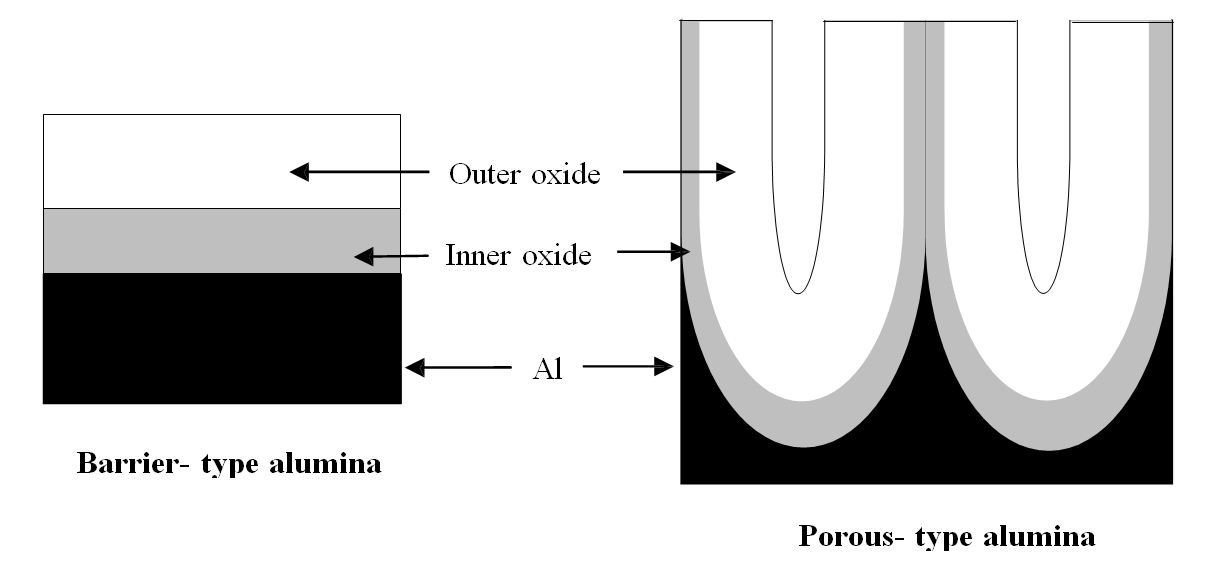
Figure 1.1: Schematic diagram for barrier type alumina and porous type alumina. The aluminum metal, an inner oxide consisting of pure alumina and an outer oxide consisting of an anion-contaminated alu- mina are indicated.
According to the Manchester group [20, 21, 22, 23, 24], the degree of incorporation of elec- trolyte species in the outer oxide layer of barrier-type alumina strongly depends on the type of electrolyte, the concentration of adsorbed anions, and the faradaic efficiency of film growth. This group found that the electrolytes can be classified into three categories in terms of ionic mobility in the oxide; immobile, outwardly mobile, and inwardly mobile ions. Table 1.2 shows the direction of the mobility of electrolyte species, which is determined by the type of the charge of electrolyte species in the film. For example, if the incorporated species are cations, they would move outwardly during the anodic reaction in Al. Immobility of electrolyte species can be attributed to effectively no charge in the film (compensated or low mobility). Therefore, the thickness of the outer oxide film is strongly influenced by the directionality of the electrolyte species.
1.4.2 Oxide thickness as a function of applied potential
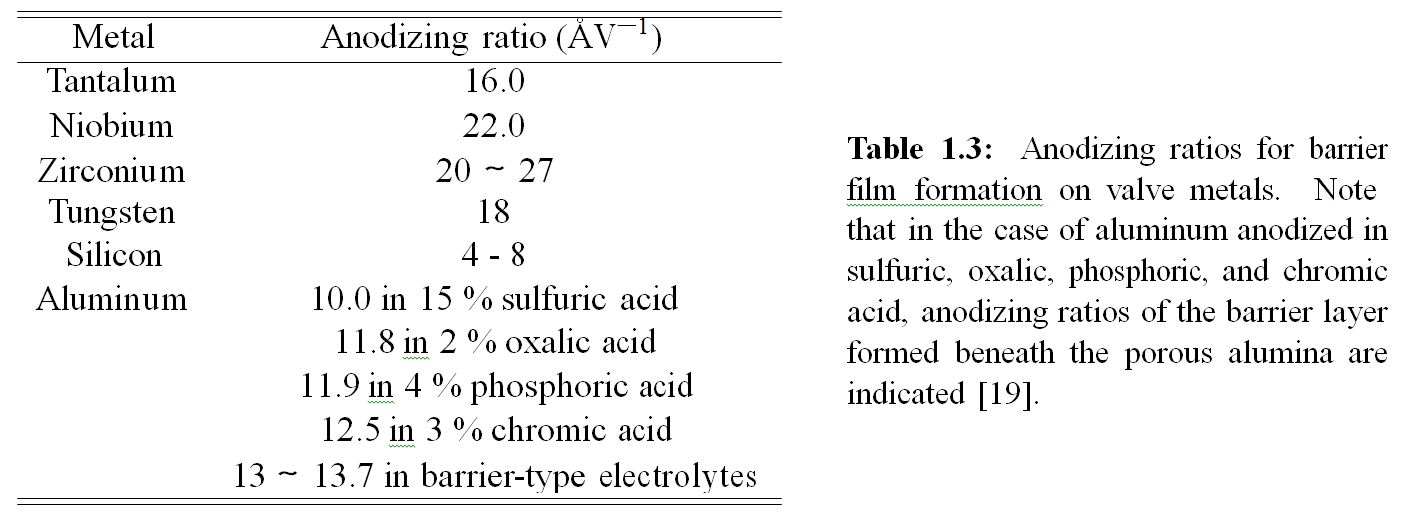
It is generally accepted that the thickness of barrier-type alumina is mainly determined by the applied voltage, even though there is a small deviation depending on the electrolytes and tem- perature [19, 24, 42, 43]. The anodizing ratio, which is defined as oxide thickness formed per volt, demonstrates that the barrier type films are also strongly influenced by the type of metal which is anodized as shown in table 1.3. The maximum attainable thickness in the barrier-type alumina film was reported to be less than 1 µm, corresponding to breakdown voltages in the range of 500 ∼ 700 V. Above the limited voltage (or actually the breakdown electric fields, EB0), dielectric breakdown of the films occurs [19]. On the other hand, since the thickness in the porous alumina film is time-dependent, much thicker films than those in barrier-type films can be obtained [19]. Anodizing time, current density and electrolytes are important parameters in determining the film thickness of porous alumina. For instance, thick, compact, and hard porous films are formed at low temperatures (0 ◦ < T < 5 ◦, so-called hard anodizing conditions), whereas thin, soft, and non-protective films are produced at high temperature (60 ◦ < T < 75 ◦, so-called soft anodizing conditions). As the temperature increases, the corresponding current density also increases. This does not mean that a higher current density increases the film thickness since the rate of complex dis- solution at the electrolyte/oxide interface increases, too. If the temperature is too high so that the rate of dissolution is faster than that of oxide formation, the film even vanishes, resulting in electropolishing of aluminum [19, 37]. The thickness of the thin barrier layer at the bottom of the porous structure is only dependent on the anodizing voltage, regardless of anodizing time. However, electrolyte effects on the anodizing ratio in the barrier films have to be considered. For example, 14A˚ /V, 8A˚ /V, and only 1A˚ /V were reported in a dilute, 40, and 90 % (w/w)3 sulfuric acid, respectively [19, 42]. Comparing the anodizing ratio of the barrier-type oxide formed in non-dissolving electrolytes, the electrolyte effect can be ascribed to the dissolution of the formed oxide in acidic electrolytes.
1.4.3 Pore formation mechanisms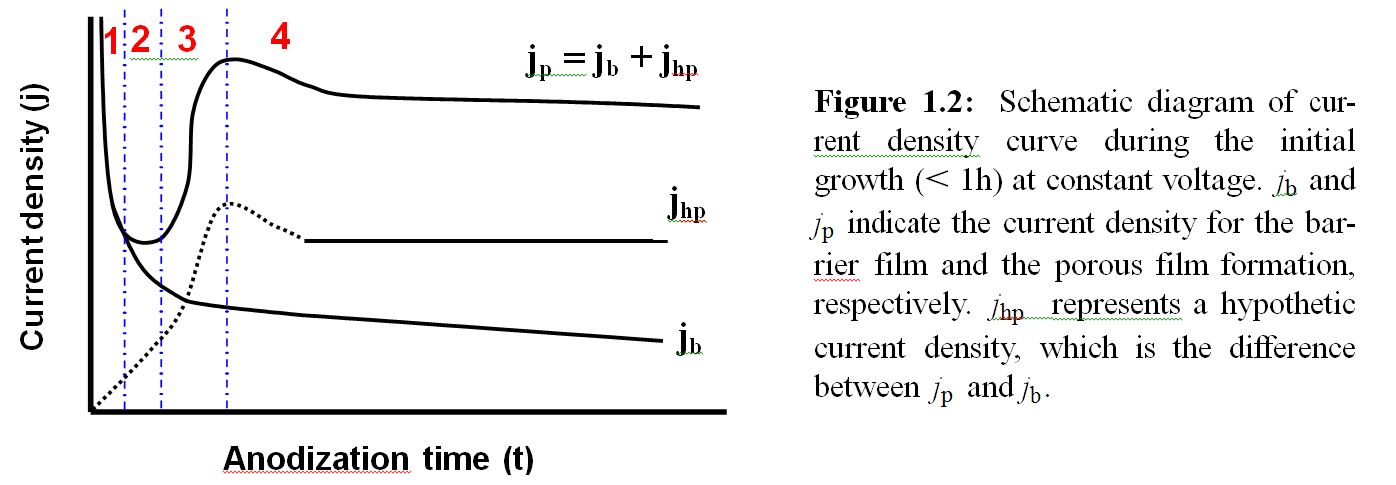
The transient of the potentiostatic current density reflects the formation of barrier-type or porous- type porous alumina (see Fig. 1.2) [19, 36, 44, 45, 46]. At the beginning of the oxide formation, both transients have an identical behavior. However, for the barrier film formation, the current density jb decays exponentially. Eventually, the barrier film current is dominated by an ionic current ji .In the case of the formation of porous films, the following current density profiles are typically observed [19, 36, 44, 45, 46]. First, the current density jp decreases rapidly (regime 1 in Fig.1.2). Then, it passes through minimum value (regime 2 in Fig. 1.2). It increases to arrive at a maximum value (regime 3 in Fig. 1.2). Subsequently, it slightly decreases again. Finally, a steady current density remains (regime 4 in Fig. 1.2). One can consider the current density jp as the sum of jb and hypothetic current density jhp , which means the pure current density for creating pores. jb is determined by the applied potential in terms of the anodizing ratio, while jhp depends on the electrolyte and the temperature as well as on the applied potential.
The pore formation mechanism is displayed schematically in Fig. 1.3, corresponding to the four regimes of Fig. 1.2 [26]. At the beginning of the anodization, the barrier film, which consists of non-conductive oxide ( = 1010 ∼ 1012 Ω cm [47]), covers the entire surface of the aluminum (regime 1 in Fig. 1.2 and Fig. 1.3). The electric field is focused locally on fluctuations of the surface (regime 2 in Fig. 1.2 and Fig. 1.3). This leads to field-enhanced or/and temperature- enhanced dissolution in the formed oxide and thus to the growth of pores (regime 3 in Fig. 1.2 and Fig. 1.3). Since some pores begin to stop growing due to competition among the pores, the current decreases again as shown in regime 4 in Fig. 1.2. Finally, jp maintains an equilibrated state.
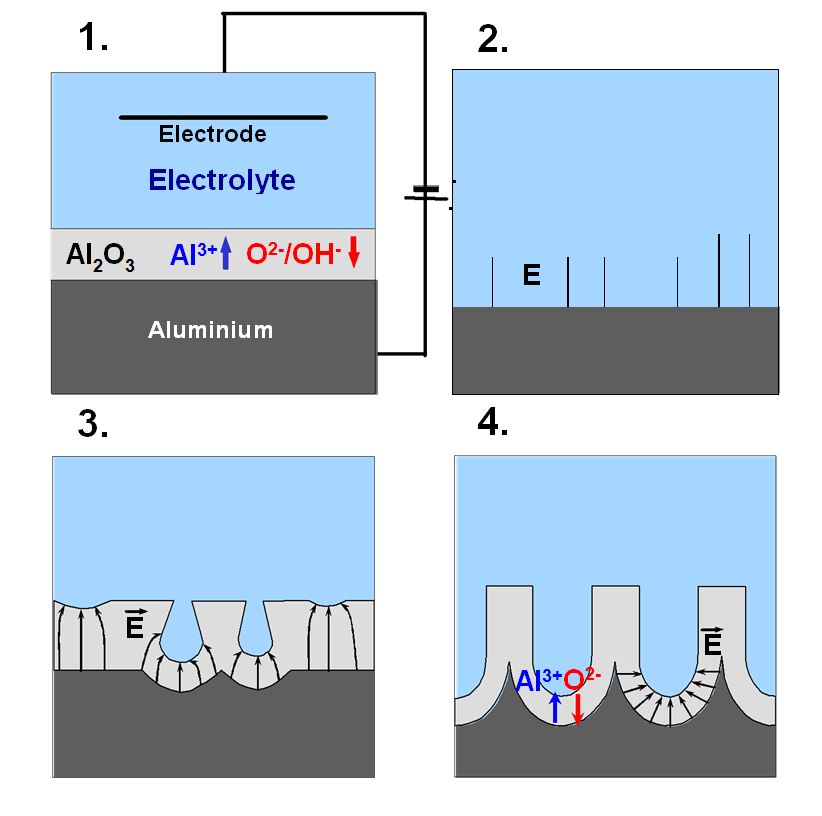
Figure 1.3: Schematic diagram of the pore formation at the beginning of the anodization. Regime 1: formation of barrier oxide on the entire area; regime 2: local field distributions caused by surface fluctuations; regime 3: creation of pores by field-enhanced or/and temperature-enhanced dissolution; regime 4: stable pore growth.
In this stage, pores grow in a stable manner. However, it is very often observed that during the stable pore growth, the current density continues to decrease slightly. This is due to diffusion limits in the long pore channels [45, 46].
1.5 Self-ordered porous alumina - current state-of-the-art
The method discovered by Masuda et al. relies on self-ordering of pores at the bottom of porous alumina channels after a long first-anodization step [34]. The driving force for self-assembly has been attributed to mechanical stress caused by the repulsive forces between neighboring pores during anodization [48, 49].4 Several previous studies revealed that self-ordered porous alumina structures can only be ob- tained under specific conditions. For example, structures with pore spacing of 50, 65, 100, 420 and 500 nm are fabricated at 19 V and 25 V in sulfuric acid, at 40 V in oxalic acid, and at 160 V and 195 V in phosphoric acid, respectively [46, 50, 51, 52], as seen in Fig. 1.4.
1.5.1 Experimental set-up
Fig. 1.5 shows an apparatus of our electrochemical experiments (anodization and electrochem- ical deposition) [44, 45]. The electrochemical cell consists of a two-electrode system, e.g., the Platinum (Pt) mesh acting as the counter electrode (B in Fig. 1.5) and Al sheet acting as the working electrode (F in Fig. 1.5). The Al sheet is inserted between the electrolyte container D in Fig. 1.5) and brass plate (G in Fig. 1.5) and fixed by screws (E in Fig. 1.5). To stir the electrolytes vigorously, a motor-controlled agitator is used (A in Fig. 1.5). The apparatus is operated by a computer (I in Fig. 1.5), using home-made software. The cell was clad with sty- rofoam acting as the thermal insulator (C in Fig. 1.5). For cooling the apparatus, a combination of water-cooling and a Peltier element is employed (J in Fig. 1.5). The potentiostat/galvanostat (Keithley 2400) has a working range of either 0 ∼ 210 V (potentiostatic mode) or 0 ∼ 100 mA (galvanostatic mode) as shown in H of Fig. 1.5.
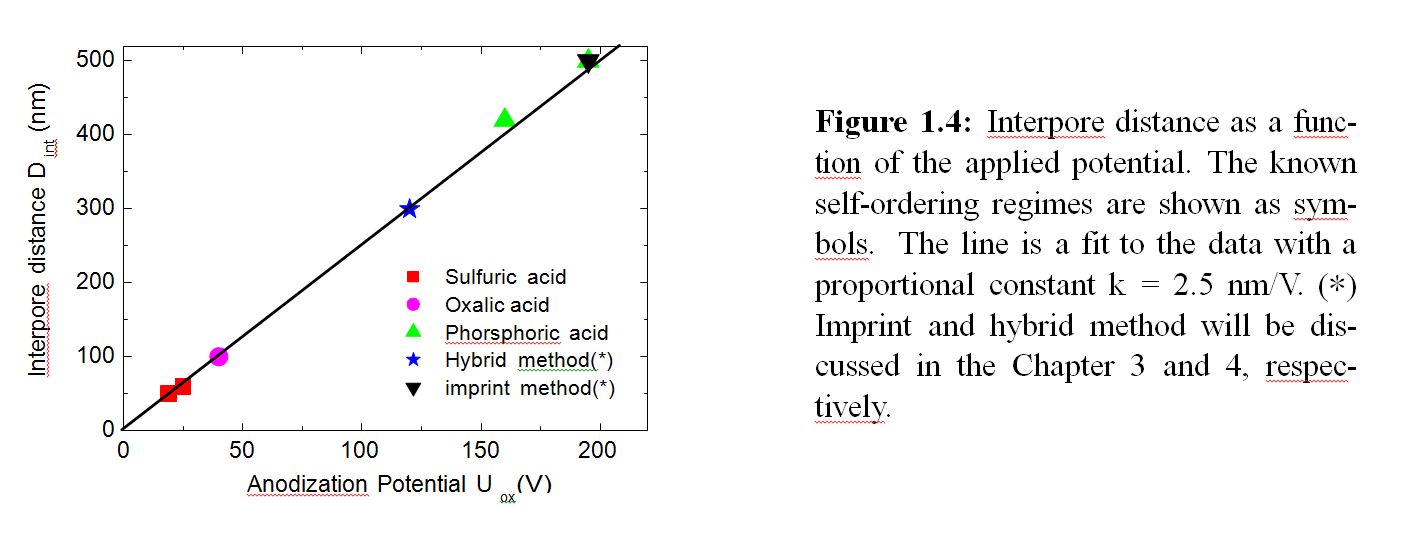
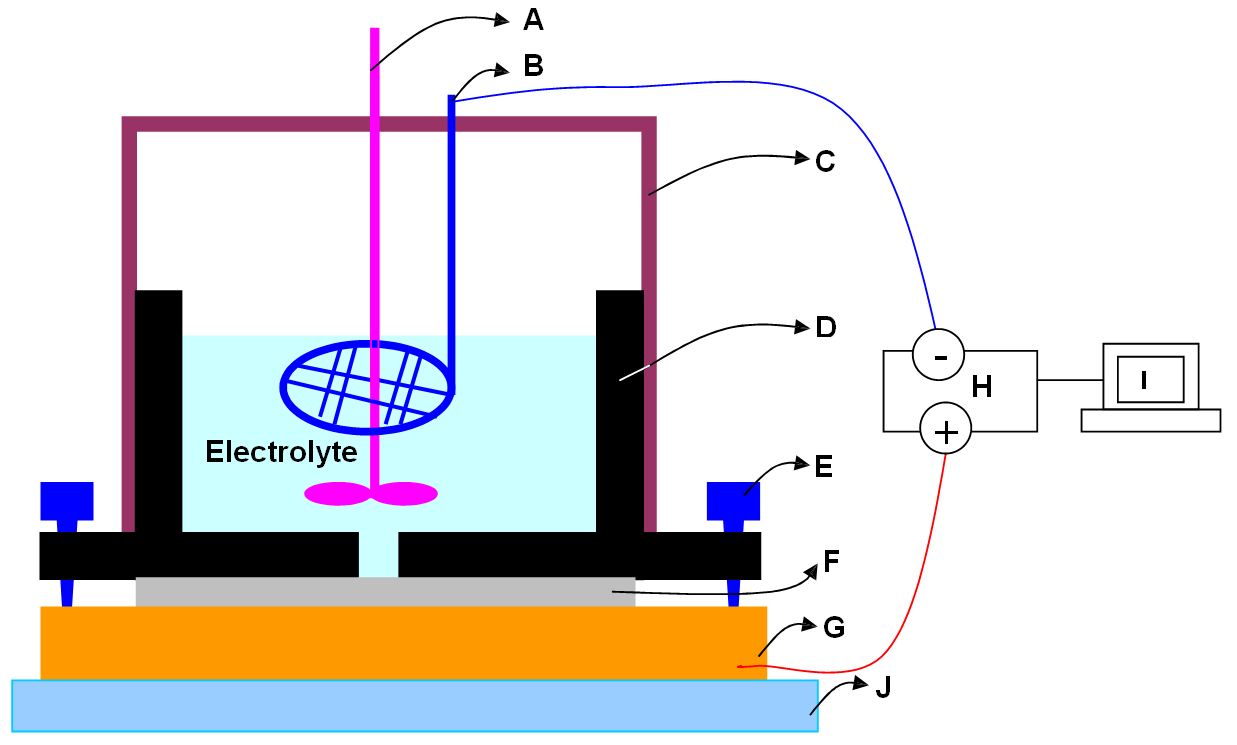
Figure 1.5: Schematic diagram of the apparatus used for the anodization. A: Motor-controlled rotator for agitating the electrolyte, B: Pt mesh working as counter electrode, C: isolator consisting of an outer styrofoam layer and inner brass layer, D: electrolyte container made of teflon, E: screw for fixing the electrolyte container to the brass plate, F: aluminum sheet, G: brass plate working as electric conductor connected with a positive electric source, H : potentiostat/galvanostat (Keithley), and I: computer to operate the potentiostat/galvanostat and the cooling, J: Peltier cooling element.
Figure 1.6: Stages of the formation of self-ordered alumina: a) Annealing at 500◦C for 3h; b) electropol- ishing in a solution of 1/4 HClO4 + 3/4 C2H5OH for 4 min at 8 V with agitation; c) first anodization (typically 1 ∼ 2 days); d) selective dissolution of the formed oxide layer; e) second anodization under the same conditions as the first anodization; and f) isotropic etching in 1 M phosphoric acid at 30◦C to widen the pores.
Experimental procedures are described in detail in Fig. 1.6 [44, 45]. Firstly, aluminum with a high purity (99.99 %) is cleaned with acetone in an ultrasonic bath. Then, it is immersed in 100 ml of a mixture containing HF/HNO3 /HCl/H2O at a ratio of 1:10:20:69 in order to remove impurities on the surface. After cleaning with deionized (DI) water (Ωm2 > 106), Al is annealed for 3 h at 500 ◦C in N2 to obtain large single cystalline grains. As a matter of fact, the larger the grains are, the larger are the domains of self-ordered porous alumina (see Fig. 1.6 (a)). To reduce surface roughness, electropolishing is carried out in a mixture consisting of 1/4 HClO4 + 3/4 C2H5OH (Fig. 1.6 (b)). Electropolishing is a prerequisite for the formation of self-ordered porous alumina with large domain size. Note that caution is needed when perchloric acid/ethanol is used due to its explosiveness at moderate temperatures. After the pretreatment, anodization is performed either at 19 V in 2 M H2SO4, at 25 V in 0.3M H2SO4, at 40 V in 0.3 M (COOH)2, at 160 V in 1 M H3PO4, or at 195 V in 0.1 M H3PO4 for more than 1 day (Fig. 1.6 (c)). Since pores are randomly created on the surface, the initial pore arrangement is very irregular (Fig. 1.7 (a)). However, due to the repulsive forces between neighboring pores during the long-anodization, self-organization occurs. As a result, hexago- nally close-packed arrays are obtained at the interface between the porous alumina layer and the aluminum substrate ((Fig. 1.7 (b))). Then, the porous alumina film is selectively dissolved in a solution containing chromic acid (Fig. 1.6 (d)) [53]. Patterns that are replicas of the hexagonal pore array are preserved on the fresh aluminium surface. This allows the preparation of pores with a high regularity by a subsequent second anodization under the same conditions as the first anodization (Fig. 1.6 (e)). If needed, the resulting pores can be isotropically widened by chemical etching with 0.5 ∼ 1 M phosphoric acid (Fig. 1.6 (f)).
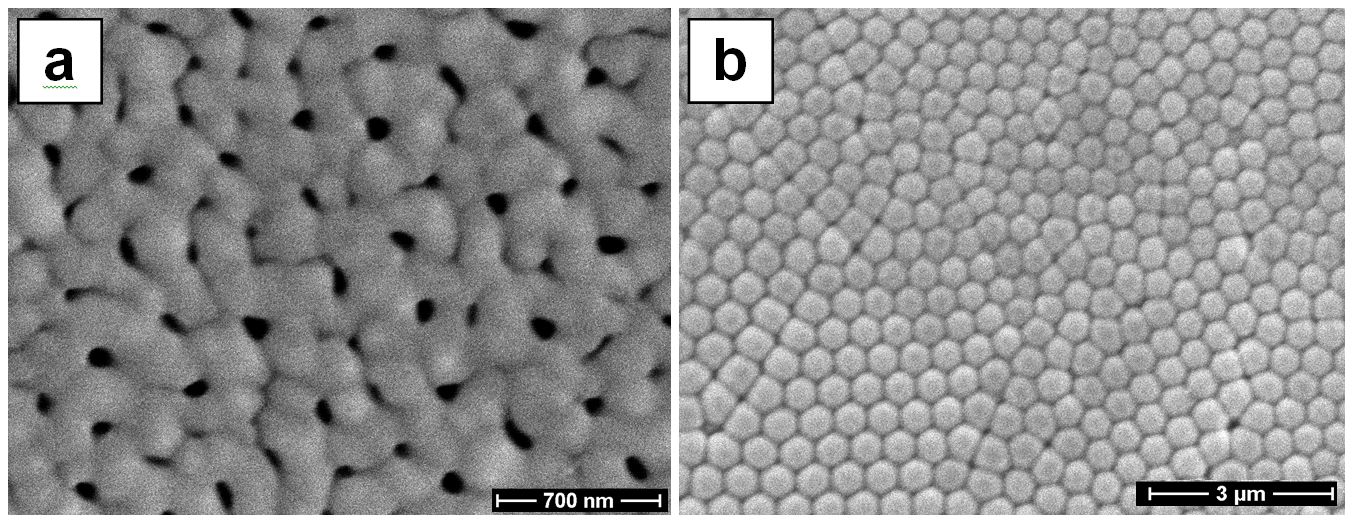
Figure 1.7: Scanning Electron Microscopy (SEM) images of a porous alumina sample produced by a first anodization (in 0.1 M phosphoric acid at 195 V). (a) the surface, and (b) the bottom of the membrane after selective removal of Al, which correspond to T and B in Fig. 1.6 (c), respectively.
1.5.3 The mechanical stress model
Jessensky et al. and Li et al. proposed a mechanical stress model to explain the formation of hexagonally-ordered pore arrays [48, 52]. They considered the following factors;
1. The oxidation takes place at the entire metal/oxide interface mainly by the migration of oxygen containing ions (O2− or OH− ) from the electrolyte.
2. The dissolution and thinning of the oxide layer is mainly due to the hydration reaction of the formed oxide layer.
3. In the case of barrier oxide growth without pore formation, all Al3+ ions reaching the electrolyte/oxide interface contribute to oxide formation. On the other hand, porous alu- mina is formed when Al3+ ions drift through the oxide layer. Some of them are ejected into the electrolyte without contributing to the oxide formation.
4. Pores grow perpendicular to the surface when the field-enhanced dissolution at the elec- trolyte/oxide interface is equilibrated with oxide growth at the oxide/metal interface.
5. The formed alumina is assumed to be Al2O3 . Therefore, the atomic density of aluminium in alumina is by a factor of 2 lower than in metallic aluminium. This means that the volume of the anodized alumina expands to about twice the original volume.
6. This volume expansion leads to compressive stress during the oxide formation in the ox- ide/metal interface. The expansion in the vertical direction pushes the pore walls upwards.
According to their studies, the degree of the volume expansion of aluminum, the volume ex- pansion coefficient ξ (see Eq. 2.5), varies with the applied potential and determines either the formation of self-ordered pores or the formation of disordered pores. If the stress is maximal (ξmax ∼ 2), no pores are generated. If the stress is too small (ξ < 1.2), the force promoting ordering is too small and a disordered porous alumina array is formed. In the case of moderate promoting forces (ξ ' 1.2), ordered pore growth occurs. If 1.3 < ξ < ξmax , the size of domains of self-ordered porous alumina will decrease and finally disappear due to the strong repulsive interactions. They concluded that self-ordered porous alumina is best formed when the volume expansion coefficient ξ ≈ 1.2.
1.5.4 Anodization parameters influencing self-ordering
Potential
The applied potential, U , is one of the most important factors to adjust self-assembly of porous alumina. As seen in Fig. 1.4, the interpore distance, Dint , is linearly proportional to the applied potential with a proportionality constant k of approximately 2.5 ≤ k(nm/V ) ≤ 2.8 [18, 24]. Dint =kU (1.9) In addition, the thickness of the barrier layer can be approximately estimated as half of the interpore distance (Dint = 2DB , where DB is the barrier-layer thickness).
Type and concentration of the electrolyte
The type and the concentration of the electrolyte for a given potential has to be selected properly to obtain self-ordered pore growth. In other words, the choice of the type of electrolyte is restricted. Usually, the anodization of aluminium is carried out in sulfuric acid in low potential ranges (ca. 5 ∼ 40 V), oxalic acid is used for medium potential ranges (ca. 30 ∼ 120 V) and phosphoric acid for high potential ranges (ca. 80 ∼ 200 V). This restriction is due to the conductivity and pH value of the electrolyte. For example, if aluminum is anodized in sulfuric acid at a high potential (note that sulfuric acid has a very high conductivity), breakdown of the oxide layer takes place very often. In addition, the pH-value of the electrolyte determines the size of the pores. The lower the pH value, the lower the potential threshold for field-enhanced dissolution at the pore tip. This leads to a smaller size of the pores. Therefore, large pore diameters are formed by using the phosphoric acid, and small pore diameter are obtained by using sulfuric acid [24, 41].
Temperature dependence
During the anodization, temperature should be kept lower than room temperature to prevent the formed oxide structure from being dissolved in acidic electrolytes. For instance, anodization at 40 V in oxalic acid is performed at 5 ∼ 18◦C and at 0 ∼ 2◦C in the case of anodization at
195 V in phosphoric acid. A second reason to keep the temperature as low as possible is to avoid a local heating at the bottom of the pores during the course of anodization (specially, in the case of anodization at a high potential). The local heat causes an inhomogeneous electric field distribution at the bottom, leading to local electrical breakdown of the oxide (see Fig. 1.8). In fact, cracks and bursts of the oxide film are generated if porous alumina is formed without temperature controlling. If the temperature is too low (just below zero degree) and diluted electrolytes are used, the electrolyte may freeze. In addition, the speed of the growth of porous alumina is affected by the temperature. The lower the temperature, the lower is the growth rate.
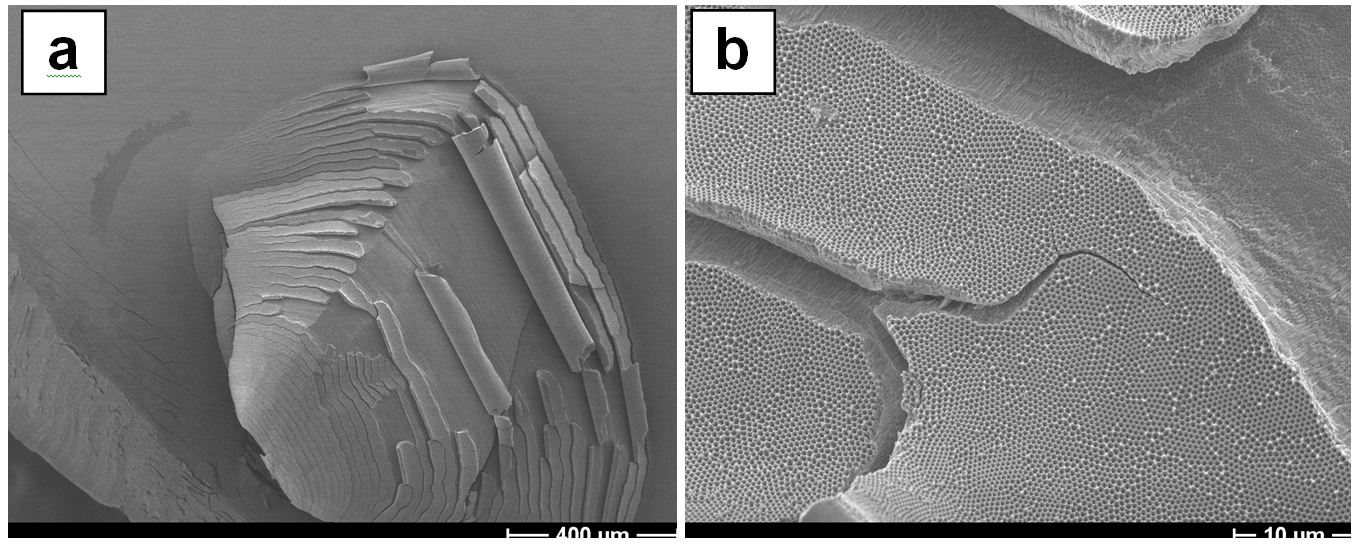
Figure 1.8: (a) SEM image of porous oxide after electrical breakdown caused by local heating. Enlarged the image is shown in Fig. 1.8 (b).
Influence of impurity
Aluminum with a high purity (≥ 99.99 %) is usually recommended to obtain self-ordered porous alumina. It is reasonable to expect that anodization of aluminum having impurities leads to defects since impurities have a different volume expansion coefficient than aluminum. To my knowledge there are no investigations about the effect of impurities on the self-ordering. In the next chapter (see chapter 3), we will discuss these effects.
Other important parameters
Additionally, annealing, electro-polishing, agitating, and the first anodizing time are important parameters to be considered to fabricate self-ordered porous alumina structures with large do- main sizes.
• The aluminum substrate is annealed below the melting point to obtain a large grain size (see Fig.1.6 (a)). Usually, an annealing process is performed at 500 ◦ C for 3h (note that the melting point of Al is 680 ◦C).
• The surface roughness is smoothed by electropolishing (see Fig.1.6 (b)) [49]. Usually, the electropolishing is performed for 1 ∼ 4 min.
• During the anodization, the electrolyte should be vigorously stirred to effectively remove hydrogen bubbles and local heat on the surface, and to allow a homogenous diffusion of anions into pore channels [49].
• The first anodizing time affects the size of domains of self-ordered porous alumina. It turned out that the domain size increases with the first anodizing time [54]. However, it was also found that the average of domain sizes decreased again if Al is anodized over a critical time.
Comments
